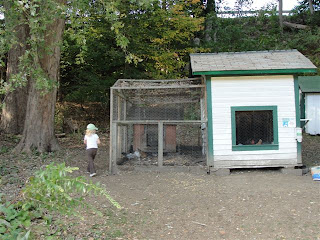I love to make a game of saving money and spending less. I try my best to get whatever I need for the lowest possible price. I keep a vigilant eye on curb sides and go hunting at yard sales and thrift stores. My husband rolls his eyes when I gleefully show off treasures I found. Scoring free stuff really makes my day and re-purposing (upcycling) is nothing short of awesome!
I've scoured several really great places within an hour's drive of our house. My first success was at Significant Elements in Ithaca, N.Y. (my old stomping grounds). It's a nonprofit architectural salvage warehouse. I shopped there one time many years back to get an old-fashioned door for our home when we became proud "home owners." I've always loved the charm of this store chock full of memories of days gone by from beautiful old houses. I found some magnificent hammered metal handles and matching hinges. Nora helped me count out enough matching screws. We picked up a few extra just in case (those with children understand me completely!). All told for two sets of hinges and two handles and screws cost $4.00. Not too shabby for a vintage touch to the coop. We toured all three floors of their building. Doors, windows, staircases, sinks, bathtubs, molding, and the list goes on.
The best part and the quintessential reason for my visit was "Free Friday." At the side of the building, was a large sign saying, "FREE." I saw most of the good stuff spirited away in a Prius (who knew they had so much trunk space?). Nevertheless, I scored a beautiful, working pair of shutters. I'm not sure how they fit into the coop design yet or even at all. As we can get some really hot spells, they may come in handy if we can add them to our building plans to ventilate the coop.
 |
| "Free Friday" at Significant Elements |
 |
| Awesome array of hardware |
I also stopped at a Habitat ReStore shop on our way to Ithaca in Corning, N.Y. I kindly asked at the front desk if they had any free or scrap wood and was directed to the back of the building. I was told you can take as much firewood as you'd like. I grinned and said, "Thank you!"
 |
| Significant Elements |
More good news to report on our jaunt to Ithaca is my godfather, Mark, was gracious enough to allow us to pick his scrap pile. He is a carpenter and builder extraordinaire and always has leftovers from jobs and remodels. Derek headed over with nest box plans to see if he could find some wood.
There were lots of wonderful leftovers. We scored an unfinished solid cherry cabinet 15" x 12" to use possibly as the base for our nesting box; four, six foot 1x4's; and two, three foot 4x4's to elevate the coop. He made us an offer we couldn't refuse ... all of this for FREE! We steered clear of the treated wood, since we want our chickens and the eggs to be as chemical-free as possible. Derek explained to him that we're building a living/green roof for the coop, and he's going to get us waterproof lining for the roof so it won't rot. Even better, Mark said to e-mail him with our wish list for building materials for the coop and he'd collect it for us as he cleaned out for his jobs. Upcycling people's refuse from remodels warms my trash-pickin' heart!
I also remembered that my mom's next door neighbor handcrafts furniture in his garage and always has wood shavings. I asked my mom to speak with him to see if we can get pine wood shavings for the nesting boxes when the day approaches that we need it. I'll return the favor to both my old neighbor and godfather by sharing the hens' eggs with them.
We still haven't made a final decision on the coop. Our plan is to show you how we make it on the cheap (pun intended), but we need to commit to a coop plan first. From our research online and in books, we understand that the essentials that makeup the anatomy of a chicken coop include: a nesting box, a roost (branch or wood that the chickens can perch on) and a chicken run where they can get outside and hang out. Important, too, is an area for feed and water. The coop must also protect the chickens from the weather and predators. Chickens don't like being wet in their home and they need enough ventilation in the summer that they don't overheat. Cats, dogs, possums, raccoons, bobcats, hawks and foxes all enjoy chicken for dinner. I'm going to avoid this scenario by properly protecting the coop and chicken run.
I'm keeping track of my expenses for the coop, so far:
- $4.00: Hardware from Significant Elements
- $12.43: Building Chicken Coops for Dummies book (Really good plans and general construction tips)
- $13.57: Chicken Coops: 45 Building Plans for Housing Your Flock book (Lacking complete building plans. Unfortunately, the coop we liked gave a web address where you can go to buy the actual plans. Great designs, drawings and photographs to get you thinking about your coop.)
- $16.47: How to Build Animal Housing: 60 Plans for Coops, Hutches, Barns, Sheds, Pens, Nest Boxes, Feeders, Stanchions, and Much More book (Diagram for nesting box, and information on living space requirements; very helpful)
- $4.20: Chickens In Your Backyard: A Beginner's Guide book (Straightforward, easy-to-read advice on raising chickens on a shoestring)
- $50.67: Out of pocket


